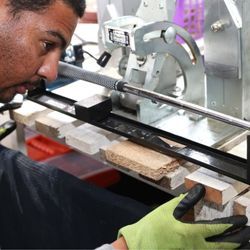Content Summary
How To Measure Golf Club Length
Are you a golfer looking to get the perfect fit? Wouldn't it be great if we could all have clubs custom-made just for us? Well, although that's not always possible, understanding how to measure for golf clubs length is the next best thing!
What is Golf Club Length?
Golf club length is an integral component of each golf club's design, and having the right length golf clubs can be the difference between successful and unsuccessful game play.
The right length of your golf clubs should provide you with maximum performance, comfort and accuracy. It should be suitable to the player's physical stature, skill set, swing type, and playing terrain.
The typical range for golf clubs starts at 33 inches (83 centimeters) for children up to 48 inches (123 centimeters) for men while women typically have slightly shorter golf clubs than men do (45 inches/110 centimeters).
The longer the club is, the further it will hit a golf ball but poor technique can create some unintended problems as too long of a golf club puts more strain on a player’s body due to over-swinging as well as messing with the players timing as well making for a greater chance of hitting off-center shots.
On the other hand, too short of a club does not allow proper rotation through your swing leading to inconsistent contact with your golf ball resulting in inaccurate shots. The proper fitting of your golf equipment is essential in finding optimal performance from them thereby improving your game and strategy when on the green or tee box.
What is the Graduated Shaft Approach?
The graduated shaft approach is an important factor in selecting the best golf clubs for your size and height. Golf clubs come with a wide variety of shaft lengths — from perfectly custom-fit to one-size-fits-all — so it’s essential for players to find the right fit for their height and swing.
The graduated shaft approach allows golfers of varying heights and abilities to select a club of the same length, creating a consistent feel from club to club. This method takes into account the player's particular swing style, age, and other personal factors necessary to ensure proper fitting.
In this method, each golfer is usually fitted according to the length they need based on their height relative to their arm length. Golfers will generally want longer drivers and longer irons compared to shorter wedges.
Generally speaking, golfers 6 feet tall or taller will use standard lengths for all 14 clubs in their bag; those that are 5’10” or less might see bigger variations - potentially with some of their longer clubs being up to an inch shorter than standard.
Once you have determined your ideal length you can start experimenting with different flexes and grip sizes until you find the perfect combination that works best for you.
What Does Using the Right Golf Club Length Do?
A long golf club shaft will provide more distance and speed, while a shorter golf club shaft will create better control.
In addition to that, using the right length ensures proper balance between the rotation of your wrists and arms as well as bending at your hips when you swing.
Furthermore, having clubs that are properly fitted also helps to avoid potential injuries due to an uneven distribution of weight throughout the body.
The wrong number of inches for certain clubs can cause excessive strain on your body during a swing, leading to conditions such as back pain or muscle fatigue in your arms and shoulders over time.
Additionally, having clubs that are too short or too long may throw off the way you strike the ball – resulting in hooks or slices instead of straight shots.
Therefore, it is important for you to ensure that each club has its own distinct length so you can make sure your shots stay true every time during play.
Taking accurate measurements is an essential step in ensuring clubs are made with optimal lengths – allowing golfers to take their game to a whole new level!
Why Do Golfers Need the Right Golf Club Length?
If a golfer uses clubs that are too long or too short, it can make his or her golf game inefficient and can even lead to injury. The club length affects the golfer's ability to hit shots accurately and with power, as well as giving them better control over the ball’s trajectory.
Having a golf club of the right length enables the golfer to utilize their body correctly during each shot and allows them to generate more power and control their ball's trajectory better.
The golf club should be long enough so that it is comfortable for the golfer, but short enough so that they are able to swing freely, correctly setting up for powerful shots when needed.
In addition, having a golf club of the correct length will help eliminate risk for injury due to incorrect posture with improper lengths. Since we tend to swing hardest from the tee the driver shaft length really needs to be spot on.
How to Choose Golf Clubs for Your Height?
Choosing the right length for your golf clubs is extremely important. It affects your swing arc, posture as well as the ball flight and power.
While most manufactures will list general guidelines for gripping and measuring golf club lengths, here are some tips that may help you to choose the best clubs for you:
1. Identify your height: Measuring from head to toe without any shoes will give you a baseline. Stand up straight with your feet slightly apart and then measure from the very top of your head to the ground.
2. Choose standardized clubs based on individual height recommendations: If you're new to golf, look at standard sets meant for beginners that come lightly shafted with preset lengths advertised in relation to individual heights (e.g., 5'2"–5'6" = Standard Tour Length).
3. Carefully custom-fit golf club length: Generally speaking, driver length should be 46"-48” tall individuals; 5’6”to 6’ tall players should select a driver between 45” -46".
Irons should typically be 1/2 inch shorter than drivers especially if they have a bulky club head, hybrid woods might be a better choice than irons. Shaft flex is an important consideration.
4. Test out grips and grips size : Grip sizes should also be taken into account when sizing for clubs as it affects weight distribution— too small of a grip size won't give adequate leverage while too large may make it difficult for small hand players to control adequately.
Also make sure that grip aligns with shoulders — test out different types of grips such as oversized or midsized grips until you find one which most comfortable works for you .
4 Factors That Impact Golf Club Length
To ensure that you’re playing with the correct length golf clubs, consider 4 different factors that can influence how long a club should be.
1. Height: A person's height is a primary factor in determining what length club should be used for better performance. Generally, the taller a person is, the longer the club needs to be in order for optimal strikes on the ball.
2. Arm Length: Although arm length relatively remains constant from individual to individual, it still plays an important role in determining proper club length.
For instance, if you have long arms then you might require a longer club than someone with shorter arms would need -- even if they are similar height as you.
3. Posture: As golfers swing their club back and forth their posture during that swing will impact what size of golf clubs they should use.
If a golfer has poor posture then they might need to purchase longer clubs to maintain consistency since one with good posture may not have as much distance between their hands and feet as someone with bad posture would have while swinging at full force.
4. Preference: Lastly, perhaps the most important factor - personal preference - can play an incredibly vital role in determining the correct size of your golf clubs.
Taking all of the above points into consideration along with how comfortable certain lengths make you feel when swinging can drastically improve performance by making it so your natural movement on the golf course complements how your clubs are sized accordingly.
Most Common Method of Measuring Club Length
To determine what size will work best for you, it’s best to have a professional do an in-person fitting. For those who don’t have access to a professional fitter or prefer to do the fitting themselves, there are several methods they can use at home.
The most common method of measuring club length is known as the “wrist-to-floor” method. This involves standing upright with arms relaxed at your sides and having someone measure from the crease in your wrist down to the floor. That measurement (in inches) will give you an exact idea of what length club works best for you.
Another method is using a golf club length chart or stock swing speed chart provided by a golf equipment manufacturer (such as TaylorMade). The chart determines swing speed based on height and age, indicating which lengths match up with different bodies and sizes.
Armed with this info, you can estimate what kind of length would work best for you before heading out to buy new golf clubs.
Finally, there are height rulers available that correspond with various manufacturers’ stock lengths and allow DIYers to determine which styles work best for their individual body type. Just place ruler against your body while standing straight up correctly and it will provide guidance on which type of club is right for you based on specs like height and arm length.

How do I size my child for golf clubs?
Sizing a child for custom golf clubs is not the same as sizing an adult. Generally, children's golf clubs need to be shorter and lighter than adult club sizes. When sizing, you should account for a child’s height, arm length, and wrist-to-floor measurement for proper length.
A child's height is important in selecting the proper golf club size because it determines the length of the shaft that will be needed. The most commonly recommended rule of thumb is to subtract 7 inches from a child’s height to get the appropriate club length. For example, if your child is 4’3", you would take 7" away from that amount and use 36" as an average size for Junior golf clubs.
Arm length is another important factor in determining whether or not a child can properly use a set of golf clubs. When measuring arm length, start at the wrist joint and measure to the top of their shoulder; this measurement should come out close to 13½ inches or 14½ inches for junior-size drivers.
If your measurement falls just shy or slightly over these guidelines, don't fret – there are adjustable/semi adjustable drivers on the market as well as custom fit drivers from several golf club manufacturers like TaylorMade Golf and UNEEDA Golf that can help bridge any gap in size.
Finally, it's important to measure how far your child's wrist hangs off their knee when they are seated on their knees (wrist-to-floor measurement). Ideally your junior golfer should measure around 11½ - 14". Anything longer than 14" may indicate the need for your youngster to use an adult size set of clubs in order to achieve pleasant results when using them out on the course.
What Length Putter Should I Use?
Choosing the correct club length for your putter length can have a huge effect on your game, and getting the perfect fit is one of the keys to perfecting your golf stroke.
Putters come in different lengths, depending upon the height of the golfer and his or her preferences. If you choose a putter that is too long or too short for you, it can cause increased strain on your shoulders and arms when making your shots.
Typically, men should use standard-length putters ranging from 33 to 36 inches in length. Women’s club lengths are usually shorter, ranging from 30 to 33 inches.
Many manufacturers have adjustable-length models available for both men’s and women’s clubs; these feature built-in adjusters which enable golfers of any size to create their ideal club length.
When measuring for a putter length, always choose a model that corresponds with your posture when preparing to take a shot.
Stand up tall and grip your chosen club lightly; if you feel any tension in your shoulders or arms when you swing back and forth, adjust accordingly by either reducing or increasing the length of your club until it feels more comfortable.
When deciding whether you are using too long or short of a putter, pay attention to how close you feel able to get with consistent accuracy. Compensating by changing your grip is an indication that what you have just may not be long (or short) enough!
Thank you for visiting and we hope to see you back soon!






